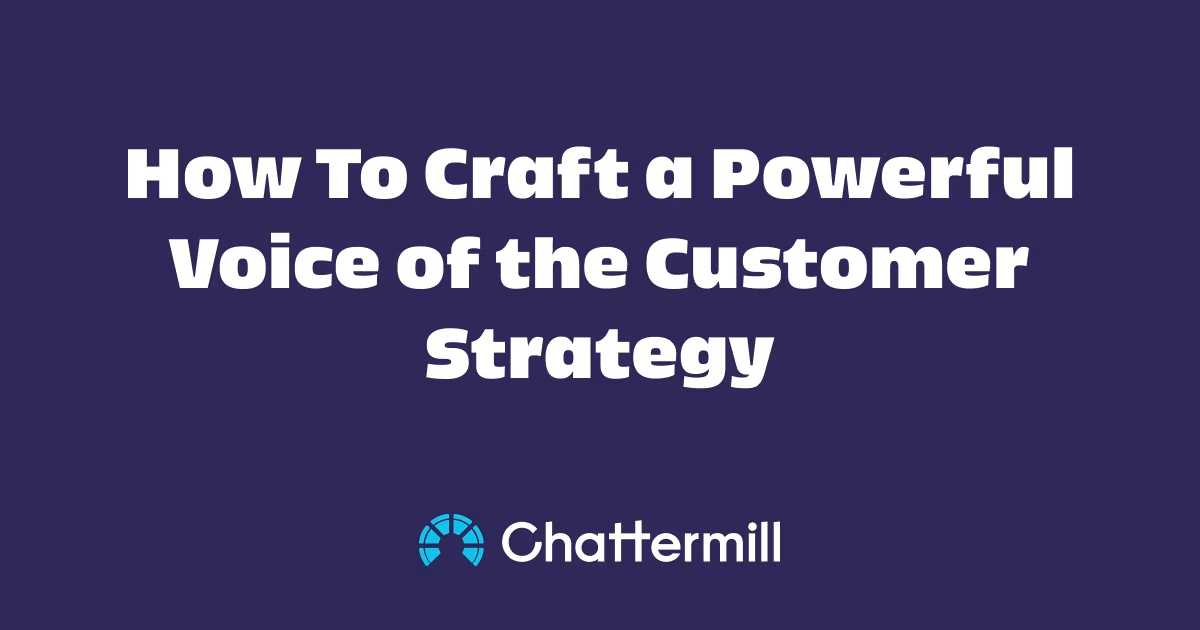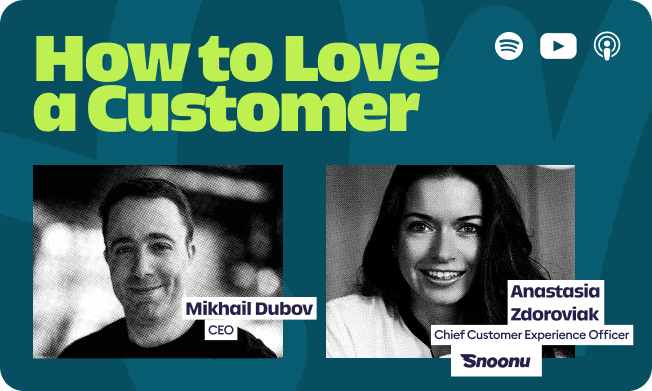Gathering customer data is only the beginning. A Voice of the Customer (VoC) strategy is the plan that turns raw feedback into business transformation. With the right strategy, companies move from simply collecting insights to acting on them, creating loyal customers and staying ahead of competitors.
What is a Voice of the Customer Strategy?
A Voice of the Customer strategy is a structured plan for capturing, analyzing, and acting on customer feedback. It arms your organization with the information to understand what your customers want, what frustrates them, and what delights them.
This strategy impacts every part of your business:
- Product development: Use insights to refine features or launch new products that match customer needs.
- Marketing: Sharpen messaging and tailor campaigns to customer pain points and motivations.
- Digital teams: Improve website UX, content performance, and SEO visibility.
- Customer support: Deliver faster, more empathetic service aligned with customer expectations.
These business functions, and others, can use VoC data to enhance all stages of the customer's journey and address any pain points. Successfully implementing a Voice of the Customer program will bring you closer to your customers, but will also encourage better collaboration between internal teams too.
5 Steps to Building a VoC Strategy
Creating a successful strategy requires more than tools. It’s about aligning teams, goals, and execution. Each step should be practical, actionable, and measurable.
1. Define Objectives
A VoC strategy must start with purpose. Ask:
- What business challenge are we solving (churn, product adoption, NPS drop)?
- What KPIs will prove success? (e.g., retention +5%, NPS +10 points)
- Which customer segments matter most?
Pro tip: Keep objectives SMART (specific, measurable, achievable, relevant, time-bound). For example, “Reduce onboarding churn by 15% in Q4 by analyzing VoC feedback from first 30 days.”
Related Reading: Customer Retention Metrics
2. Choose the Right Tools
VoC programs fail when data is fragmented. Your strategy should specify:
- Data sources (surveys, reviews, social, chat, calls, CRM)
- Collection methods (always-on feedback vs campaign-based)
- Analysis tools (AI text analytics, dashboards, tagging systems)
Example: Chattermill integrates with 60+ platforms including Zendesk, SurveyMonkey, and Trustpilot, unifying them into one analytics layer. This eliminates silos and creates a single source of truth.
Related Reading: Top 10 Voice of the Customer Tools
3. Collect Feedback Across Channels
Diversify input to get a complete picture:
- Direct feedback: NPS, CSAT, CES surveys, interviews, customer calls
- Indirect feedback: Reviews, forums, social media mentions
- Inferred feedback: Website behavior, product usage, churn patterns
Pro tip: Map collection points to the customer journey. For example:
- Pre-purchase: reviews, website behavior
- Onboarding: NPS, surveys
- Post-purchase: support tickets, returns feedback
Related Reading: How to Analyze Customer Feedback in Retail
4. Analyze and Share Insights
Raw data is useless without analysis. Your strategy should define:
- Analytical methods (sentiment analysis, theme categorization, churn prediction)
- Data distribution (dashboards for execs, filtered views for product or support teams)
- Cadence (weekly reviews vs quarterly deep-dives)
Pro tip: Democratize insights. Don’t keep VoC locked with analysts. Let frontline teams self-serve insights so they can react in real time.
Related Reading: Voice of the Customer Analysis
5. Act and Continuously Improve
A VoC strategy must close the loop:
- Translate insights into initiatives (e.g., shorten checkout flow, improve onboarding emails)
- Measure impact with before/after KPIs
- Communicate back to customers — “You said, we did.”
Pro tip: Use a feedback loop framework (Collect → Analyze → Act → Share → Refine). This shows VoC is not a one-off project but a living strategy.
Related Reading: Customer Feedback Loop
Benefits of a Strong VoC Strategy
1. Become a Truly Customer-Centric Business
Listening to customers consistently is one of the strongest levers for growth and long-term retention.
2. Gain Deeper Understanding of Customer Behavior
Customers often act differently than brands expect. A VoC strategy puts you in their shoes and highlights gaps between perception and reality.
3. Strengthen Customer Relationships
Acting visibly on feedback demonstrates care, building trust and loyalty over time.
4. Drive Continuous Improvement
Regular insights highlight issues and opportunities for ongoing refinements to products, services, and experiences.
5. Stay Ahead of Competitors
VoC data reveals emerging market trends, enabling you to pivot quickly and capture advantage.
6. Improve Internal Collaboration
When all teams align around shared customer insights, they collaborate more effectively toward unified goals.
7. Build Better Products and Services
Understanding what customers truly value helps prioritize product roadmaps and service innovation.
How To Collect Useful Customer Data
Voice of Customer programs can pull data from myriad sources. Choose the most appropriate methodologies to achieve your specific aims. It’s common practice to incorporate multiple sources, rather than relying solely on one.
Direct feedback sources include:
- Customer surveys
- Customer interviews
- Focus groups
- Net Promoter Score (NPS), Customer Effort Score(CES), Customer satisfaction (Csat) online surveys
- Customer calls.
This is direct communication between your business and its customer base to glean useful responses. It’s a straight forward dialogue between you and them, asking specific questions. It’s important to ask the right interview or survey questions though, in order to get valuable insights that you can act upon. A simple ‘yes’ or ‘no’ isn’t as useful as a fuller explanation.
Indirect feedback sources include:
- Online reviews and ratings
- Social media comments
- Forum discussions.
This is unsolicited feedback. People are likely to speak differently about your brand when they’re not commenting on a brand platform.
Inferred feedback sources include:
- Website data analytics
- App usage and downloads
- Social media metrics.
These metrics give details of customer behavior online, such as time spent on site, page views, referrals and search terms used. It shows what customers actually do, rather than what they say. There’s often disparity between the two.
Organizing, Analyzing, and Acting on Feedback
Now you’ve gathered the customer data, you need to do something with it to make it useful. You could dedicate significant time and effort into manually looking through survey responses, social media comments, website data and more. You could input the data on a spreadsheet and create graphs and charts. Or you could automate this process by using an efficient, AI powered VoC tool.
Manually reviewing survey responses, call transcripts, and reviews is slow and error-prone. Platforms like Chattermill’s Unified Customer Intelligence use AI to analyze all feedback in one place, surfacing actionable insights instantly.
It’s important to look for trends in your data. You don’t need to change your product to reflect every piece of market research - that’s not viable or realistic. However, if you notice that several users with a high customer lifetime value (CLV) cite the same pain point, it’s worth looking for a remedy. If website metrics highlight a drop in visitors or conversions, it needs to be investigated. Perhaps a certain marketing persona isn’t engaging with a campaign. That reflects a need to tweak the messaging or channels being used. Maybe the pricing of a new product or service is the issue. Knowledge of the customer issues is power.
This VoC analysis will result in a list of ideas, features and fixes to be worked on. Your organized data will inform the priorities. You can work on the ideas knowing your choices are driven by customer feedback. It’s useful to consider:
- Impact: will this fix have a significant, positive impact on your customer base?
- Confidence: how confident are you that this can be dealt with now?
- Ease: is it a quick fix or does it require longer time from your team or external providers?
Case Studies: Voice of the Customer in Action
ManoMano
The ManoMano team wanted to adopt a more customer-centric approach to their business. They partnered with Chattermill to gain a single source of truth which would empower teams to make better decisions.
ManoMano leveraged Chattermill's cutting-edge technology to analyse their customer feedback in near real-time and at a granular level. That insight helped ManoMano to gain a deeper understanding of their customers and identify the underlying root causes of their challenges. Plus, they were able to scale a customer-centric culture internally across the organisation through successful customer feedback management.
Monica Vinader
The luxury jewelry brand used Chattermill dashboards to unify feedback across CX, support, and eCommerce. By making data accessible company-wide, they identified churn drivers and energized teams to take faster action.
Read Monica Vinader Case Study
Limehome
Europe’s leading serviced apartment provider leveraged Chattermill to channel VoC insights across operations. Results included a 20% increase in NPS and an 81% increase in nights booked between 2021–23.
Use Customer Feedback to Drive Business Success
When you capture, analyze, and act on customer feedback, you transform it into a competitive advantage. A well-executed VoC strategy improves products, strengthens relationships, and drives revenue growth.
Want to see how Chattermill empowers teams with real-time VoC insights?
Voice of the Customer (VoC) Strategy: FAQs
1. What is a Voice of the Customer (VoC) strategy?
A Voice of the Customer (VoC) strategy is a structured approach to capturing, analyzing, and acting on customer feedback. It ensures that business decisions are aligned with customer needs and expectations.
2. Why is a VoC strategy important?
A strong VoC strategy helps businesses improve customer satisfaction, reduce churn, and drive loyalty. It transforms feedback into actionable insights that guide product, service, and experience improvements.
3. What are the key components of a VoC strategy?
The main components include feedback collection, data analysis, cross-team collaboration, and closing the loop by acting on insights and communicating changes to customers.
4. How do businesses collect feedback for a VoC strategy?
Feedback is collected through surveys, interviews, reviews, social media monitoring, focus groups, and customer support interactions.
5. How does a VoC strategy improve customer experience?
By uncovering customer pain points and preferences, a VoC strategy enables businesses to make targeted improvements that reduce friction and enhance satisfaction across the customer journey.
6. What role does technology play in a VoC strategy?
Technology supports VoC initiatives through analytics platforms, AI-driven sentiment analysis, and real-time dashboards that make insights easier to track and act on at scale.
7. How do you measure the success of a VoC strategy?
Success can be measured through metrics such as Net Promoter Score (NPS), Customer Satisfaction Score (CSAT), Customer Effort Score (CES), retention rates, and revenue growth linked to customer experience improvements.
8. What challenges do businesses face when building a VoC strategy?
Common challenges include managing large amounts of unstructured data, ensuring cross-team collaboration, and turning feedback into tangible action that customers notice.















